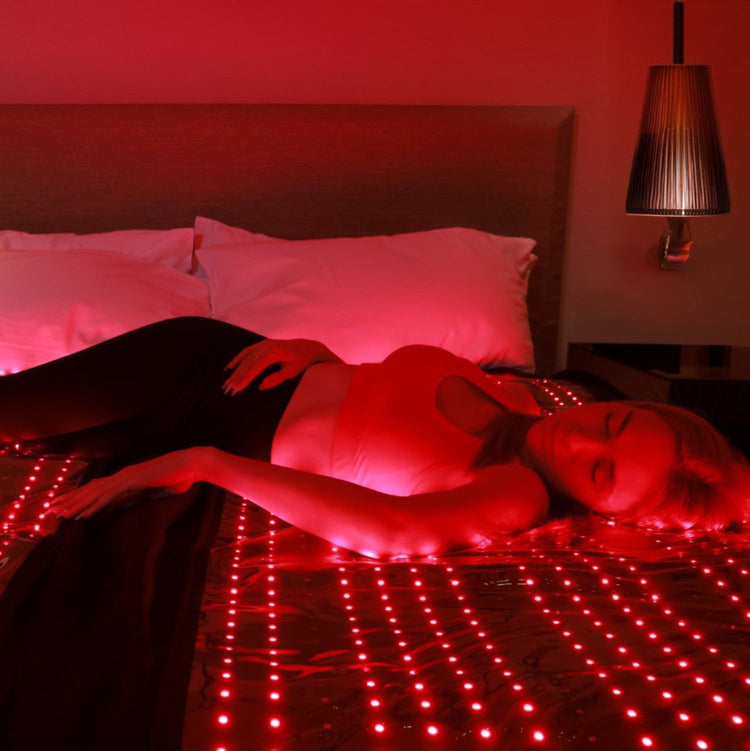
How to Use Red Light Therapy for Sleep: A Comprehensive Guide
Table of Contents
- Introduction to Red Light Therapy for Sleep
- How Red Light Therapy Enhances Sleep
- Best Practices for Using Red Light Therapy for Sleep
- Optimal Timing
- Duration and Frequency
- Placement and Distance
- Combining Red Light Therapy with Other Sleep Strategies
- Nicebeam Full Body Red Light Therapy Bag: The Best Choice for Sleep
- Frequently Asked Questions
- Conclusion
- Summary Table
Introduction to Red Light Therapy for Sleep
Red light therapy (RLT) is gaining popularity as a natural and effective way to enhance sleep quality. Unlike blue light, which disrupts melatonin production, red and near-infrared (NIR) light wavelengths help regulate circadian rhythms, improve relaxation, and promote deeper sleep.
This guide explores the benefits of red light therapy for sleep, the best ways to use it, and why the Nicebeam Full Body Red Light Therapy Bag is an excellent choice for optimizing sleep patterns.

How Red Light Therapy Enhances Sleep
Red light therapy works by delivering low-level wavelengths of light (typically 660nm red light and 850nm near-infrared light) that penetrate deep into the skin and cells. This process:
- Regulates melatonin production – Encourages natural sleep-wake cycles.
- Reduces cortisol levels – Helps decrease stress and anxiety, promoting relaxation.
- Improves mitochondrial function – Enhances cellular energy and repair, contributing to better overall sleep quality.
- Enhances blood circulation – Improves oxygen and nutrient delivery, leading to muscle relaxation and recovery.
- Reduces inflammation and pain – Alleviates discomfort that may interfere with sleep.
Best Practices for Using Red Light Therapy for Sleep
Optimal Timing
To maximize the sleep benefits of red light therapy, use it 30-60 minutes before bedtime. This helps signal to your body that it’s time to wind down and prepare for sleep.
Duration and Frequency
For optimal results:
- Use 10-20 minutes per session.
- Apply red light therapy 3-5 times per week.
- Avoid overuse, as excessive exposure may reduce its effectiveness.
Placement and Distance
Proper positioning enhances the effectiveness of red light therapy:
- Place the device 12-24 inches away from the skin.
- For full-body exposure, use a full-body red light therapy device like the Nicebeam Full Body Red Light Therapy Bag.
- Ensure even exposure by positioning yourself comfortably in front of the light source.
Combining Red Light Therapy with Other Sleep Strategies
To enhance sleep quality, combine red light therapy with:
- A consistent sleep schedule – Go to bed and wake up at the same time daily.
- Avoiding blue light exposure before bedtime – Reduce screen time 1-2 hours before sleep.
- Relaxation techniques – Practice deep breathing, meditation, or gentle stretching.
- A comfortable sleep environment – Keep your room dark, cool, and quiet.
Nicebeam Full Body Red Light Therapy Bag: The Best Choice for Sleep

The Nicebeam Full Body Red Light Therapy Bag is an award-winning FDA-approved device designed to provide full-body exposure to red (660nm) and near-infrared (850nm) light for sleep improvement.
Key Features:
- Full-body coverage – Available in 160cm x 60cm (63in x 23.6in) and 180cm x 80cm (70.8in x 31.5in) sizes.
- 2646 high-quality LEDs – Ensures powerful and even light distribution.
- Adjustable brightness (1%-100%) – Allows customization based on personal comfort.
- Customizable timer (1-60 minutes) – Set therapy duration as needed.
- Lightweight and portable (8 pounds) – Easy to use at home or while traveling.
- Safe and effective – Made with medical-grade neoprene for durability.
How to Use the Nicebeam Red Light Therapy Bag for Sleep:
- Unroll the therapy bag and place it on your bed, couch, or any flat surface.
- Adjust the brightness based on your comfort level.
- Set the timer for 10-20 minutes before bedtime.
- Lie down and relax, allowing the red light to penetrate your skin and muscles.
- Turn off the device and proceed with your sleep routine.
This device is also beneficial for:
- Muscle recovery – Speeds up post-workout healing.
- Pain relief – Reduces chronic pain and inflammation.
- Skin rejuvenation – Enhances collagen production and reduces wrinkles.
- Pet therapy – Safe and effective for pets needing red light therapy.
Frequently Asked Questions
1. Is red light therapy safe to use before sleep?
Yes, red light therapy is completely safe and has been shown to improve sleep quality by promoting melatonin production and relaxation.
2. How long does it take to see results from red light therapy?
Most users notice improved sleep within 1-2 weeks of consistent use (3-5 times per week). However, individual results may vary.
3. Can I use red light therapy every night?
While red light therapy is safe, using it 3-5 times per week is generally recommended for optimal results. Using it daily in shorter sessions (10 minutes) is also an option.
Conclusion
Red light therapy is a scientifically backed solution for improving sleep quality, reducing stress, and enhancing overall well-being. By using red (660nm) and near-infrared (850nm) light, devices like the Nicebeam Full Body Red Light Therapy Bag help regulate melatonin production, reduce inflammation, and support relaxation.
For best results, follow the recommended timing, duration, and placement practices, and integrate red light therapy into a comprehensive sleep routine.
Summary Table
| Feature | Details |
|---|---|
| Best Timing | 30-60 minutes before bedtime |
| Recommended Duration | 10-20 minutes per session |
| Frequency | 3-5 times per week |
| Distance from Skin | 12-24 inches |
| Best Device for Full-Body Therapy | Nicebeam Full Body Red Light Therapy Bag |
| Key Benefits | Regulates melatonin, reduces stress, enhances muscle recovery |
| Additional Features | Adjustable brightness (1%-100%), timer (1-60 min), medical-grade neoprene |
| Other Uses | Pain relief, skin rejuvenation, pet therapy |
By incorporating red light therapy into your nightly routine, you can enjoy deeper, more restful sleep and wake up feeling refreshed and energized.